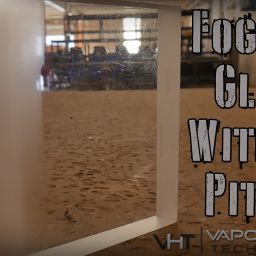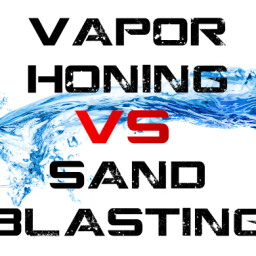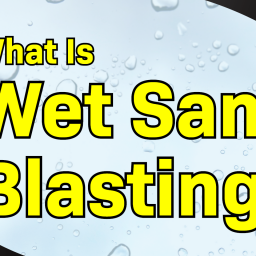Soda Blasting Safety: Is Soda Blasting Safe to Breathe?
The global sodium bicarbonate (NaHCO3) market had an estimated value of $1.73 billion in 2020. Come 2024; experts project its worth to balloon further.
After all, NaHCO3, also known as baking soda, has numerous domestic and industrial uses. More than 10 sectors rely on this salt, and the food industry is just one of them. It’s in personal care products, pharmaceuticals, and even air pollution control.
Sodium bicarbonate is so versatile it has served as an abrasive blasting media for over 30 years now. Proper soda blasting safety protocols make it is less hazardous than other abrasives.
With all that said, you may now be wondering if soda blasting emissions are safe to breathe. Won’t this blasting method release toxic fumes or corrosive byproducts? What health and safety risks does soda blasting even pose, anyway?
We’ll answer all those questions in this comprehensive guide, so be sure to read on!
A Quick History of Soda Blasting
Soda blasting rose to fame after its use in the Statue of Liberty restoration from 1982 to 1986. Back then, the restoration engineers had to factor in structural and environmental concerns. They couldn’t just use regular abrasives on the iconic structure’s soft copper plates.
The engineers also had to worry about toxic cleaners contaminating the surrounding water. All these considerations resulted in limited cleaning and restoration approaches.
For those reasons, the restoration experts decided to test sodium bicarbonate. They found that it was gentle on materials like copper, aluminum, stone, glass, wood, and steel. They also found it to have no damaging effects on parts like bearings, seals, and valves.
After extensive testing, the New York City engineers decided to go with soda blasting. The project’s success highly publicized the use of soda as a blasting medium.
General Safety Profile of Sodium Bicarbonate
Most consumer products contain sodium bicarbonate at levels Generally Regarded As Safe (GRAS). It has a low toxicity risk in humans and is non-combustible. However, direct exposure to this compound can cause mild skin and eye irritation.
So, Is Soda Blasting Media Safe to Breathe?
At low levels, inhaled sodium bicarbonate is unlikely to cause any health effects. However, direct inhalation of large amounts can cause sneezing or coughing. That’s why it’s still a must to use dust masks or respirators, even if you’re only blasting away with baking soda.
Soda Blasting Safety Profile vs. Other Abrasive Blasting Media
One of the primary hazards of traditional sandblasting is its hazardous air emissions. This applies to both the abrasive agents used and the surface that requires abrasion. They may contain toxic minerals, such as crystalline silica, and metals like beryllium.
Baking soda may be a mild irritant, but it doesn’t contain such dangerous substances.
No Crystalline Silica Emissions
Unlike other blasting media, such as sand, soda doesn’t release crystalline silica. Crystalline silica is a mineral classified as a human lung carcinogen. More than two million US workers are at risk of exposure to this cancerous agent.
Aside from sand, crystalline silica is also in concrete, mortar, and stone. One of the chief concerns about crystalline silica is that it can cause silicosis. It’s a lung disease that doesn’t have a cure, can result in permanent disability, or can even be fatal.
Exposure to crystalline silica also comes with a higher risk of lung cancer. Researchers also say that it can contribute to esophageal, stomach, and skin cancers.
Exposure to silica also heightens the risk of chronic obstructive pulmonary disease (COPD). COPD includes diseases like emphysema and chronic bronchitis. COPD may progress and worsen over time, and in some severe cases, irreversible.
Since soda blasting doesn’t emit silica, it’s a safer abrasive agent than sand. Other wet blasting abrasives without free silica are glass and ceramic beads.
No Arsenic
Some slags used for sandblasting, such as copper slag, can contain high levels of arsenic. The inorganic form of arsenic is extremely toxic and carcinogenic. It can cause skin lesions, diabetes, heart diseases, and cancers such as skin and lung cancers.
At the very least, acute arsenic poisoning can cause vomiting and diarrhea. It can also result in muscle cramps, numbness, or tingling of the extremities.
Sodium bicarbonate used in dry or wet blasting doesn’t contain arsenic. Its main component is sodium, which accounts for more than half of its molecular weight. It also consists of oxygen, carbon, and hydrogen.
Do note that excessive amounts of sodium and carbon can be poisonous. However, that would mean actually drinking or ingesting large amounts of baking soda.
No Beryllium
Coal slag is an abrasive medium associated with high levels of beryllium. Beryllium is a silvery-white metal classified as a human carcinogen. Long-term exposure to this metal can raise one’s risk of developing lung cancer.
Beryllium can also cause pneumonia and a lung disorder known as “berylliosis.” Acute berylliosis can result in severe lung inflammation, coughing, and breathlessness. Some people may also experience eye and skin irritation.
By contrast, chronic berylliosis can cause granulomas, which are abnormal inflamed nodules. It can also lead to deep lung tissue scarring and thickening.
Sodium bicarbonate won’t cause berylliosis as it doesn’t contain beryllium.
No Cadmium
Slags used in sandblasting may also have trace amounts of cadmium. Like beryllium, cadmium is also a silvery-white metal. Long-term exposure to this metal can cause organ toxicity and even cancer.
Chronic exposure to cadmium can also cause weakened bones. Scientists implicate this metal in the development of Itai-itai disease. It’s the most severe form of chronic cadmium toxicity affecting the bones.
You can avoid such health risks with the proper and safe use of sodium bicarbonate in soda blasting.
Other Properties and Advantages of Sodium Bicarbonate Blasting Media
Aside from not having toxic metals, sodium carbonate is also non-caustic. More than that, soda blasting offers a more eco-conscious way to clean heavy grease, oils, and grime. This is why many industries, from automotive to jewelry, rely on soda blasting.
On that note, let’s go over the other benefits and advantages of soda blasting.
Non-Caustic
Sodium bicarbonate is a base mild enough to be edible, which is why bakers use it as a leavening agent. It’s not like washing soda or sodium carbonate, which can be caustic at a 15% or higher concentration. To be caustic means to have the ability to burn or corrode another material by chemical action.
Almost Neutral pH Level
Sodium bicarbonate dissolved in water at room temperature has a pH level of 8.3. This makes it alkaline (or “basic”) and near-neutral, as neutral pH is 7. This makes it comparable to surface water systems that have a usual pH range of 6.5 to 8.5.
By contrast, any substance with a pH level below 7 is acidic. Many substances with a pH of less than 6.5 are also corrosive. In this way, some chemicals used in surface cleaning and finishing can leach metal ions.
As sodium bicarbonate is basic, it doesn’t have the same risks as chemical strippers. Despite this, its grainy texture makes for a great “scrubber,” hence its use as a surface cleaner.
Antimicrobial Potential
Researchers also found that sodium bicarbonate has certain anti-microbial effects. In one study, this salt showed the ability to stop the growth of bacteria like E. coli. It also inhibited the growth of Staphylococcus aureus, Pseudomonas, and yeasts.
In this way, soda blasting agents can also serve as an anti-fungal on surfaces. Hydrogen peroxide is another example of an anti-fungal, but it’s still a weak acid. If the surface you need to blast and treat is acid-sensitive, baking soda may be the way to go.
Use in Vapor Honing Technology
Vapor honing, also known as vapor blasting or slurry blasting, is a type of wet blasting technique. It involves the use of pressurized water that contains an abrasive material. This liquid mixture is what you refer to as “slurry.”
Sodium bicarbonate is one of the vapor abrasive agents you can use as part of this slurry. Baking soda has moderate water solubility, so it dissolves in water, unlike sand.
One of the things that set vapor honing apart is that it’s one of the safest solutions for lead paint removal. Note that in the US alone, lead-based paint is still in at least 3.6 million homes wherein at least one child resides. These households are among those with the highest risk of deadly lead poisoning.
Vapor honing provides a less risky way to remove lead paint as it reduces particle rebound. In this case, the liquid-based slurry entraps individuals abrasive grains and removed particles. So, instead of bouncing back, most particles get weighed down by the water.
It’s also in this way that vapor blasting reduces dust production in blasting tasks.
By contrast, dry blasting relies on the force of impact to clean or remove surface coating. So, the dry abrasives themselves can rebound and also create a lot of dust. The removed particles from the surface also add to dust production.
Reduced Waste Volume and Ease of Clean-Up
Baking soda’s physical structure and water solubility help reduce waste production. In its dry, powdered form, the salt is easy to compress and pack into disposal bags.
Sodium bicarbonate’s solubility also makes cleaning with water a breeze. Moreover, soda doesn’t bond with contaminants, unlike other abrasives like sand. It’s simple to separate the salt from contaminants by using a water solution.
You can also use a filter to separate soda-containing liquids with contaminant particles. You can then remove the solids for proper and safe disposal. So long as the liquid doesn’t have other pollutants, you may be able to discharge it to a sewage treatment system.
Soda blast media in industrial water treatment systems can also help with pH levels. This is especially true for facilities that handle acidic water. The introduction of alkaline soda can help balance the water’s pH levels.
Keeping the Salt Under Control: Proper Soda Blasting Safety Protocols
People whose jobs involve abrasive blasting must wear extensive personal protection equipment (PPE). These include breathing apparatus, air pumps, and full-face helmets. Their work area should also have adequate dust collection systems and exhaust ducts.
All those are essential to help prevent sandblasting’s detrimental health effects.
With soda blasting, PPE is still crucial, but not to the same extent. Of course, the primary goal is to limit exposure to soda by inhalation or skin and eye contact.
As such, you must still use a dust mask or a dual-cartridge respirator when using soda as a blasting media. It’s also important to always don a face shield or protective eye goggles whenever you soda blast. Gloves limits skin exposure, and earplugs protect against a blasting machine’s noise.
What to Do After Accidental Baking Soda Exposure
If you accidentally breathe in sodium bicarbonate, leave the soda-filled area right away. Move to a spot where there’s a lot of fresh air so that you can recover your breath. In the unlikely event you experience breathing difficulty, seek medical attention.
If sodium bicarbonate particles get into your eyes, wash them with plenty of clean water. Use room-temperature water to clear away the salt off of your eyes.
If you get doused with soda-based liquid, wash the area with soap and water and rinse it well. Minimal amounts of dry soda won’t hurt you, but it may sting if it gets into a wound. Wash the area right away with water to prevent possible irritation.
Consider Soda as Your Less Toxic Blasting Media Alternative
There you have it, everything you need to know when it comes to soda blasting safety. It’s safer than traditional sandblasting agents, and even OSHA recommends its use. It can also be better for the environment, which is another great incentive to make the switch.
If you’d like to learn more about soda or wet blasting, we here at Vapor Honing Technologies can help! Don’t hesitate to get in touch with us to inquire about our free application testing.








